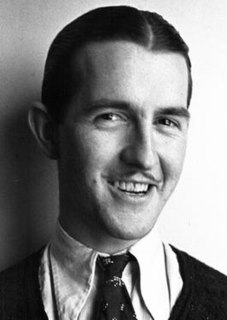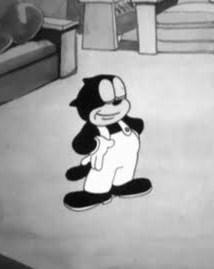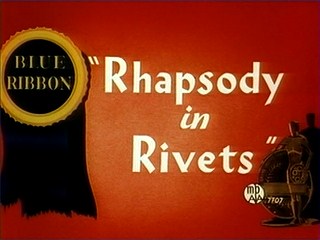
Looney Tunes is an American animated comedy short film series produced by Warner Bros. from 1930 to 1969, along with an accompanying series, Merrie Melodies, during the golden age of American animation. The two series introduced Bugs Bunny, Daffy Duck, Porky Pig, Elmer Fudd, Wile E. Coyote, the Road Runner, Tweety, Sylvester, Granny, Yosemite Sam, the Tasmanian Devil, Marvin the Martian, Pepé Le Pew, Foghorn Leghorn, Speedy Gonzales and many other cartoon characters.

Isadore "Friz" Freleng, credited as I. Freleng early in his career, was an American animator, cartoonist, director, producer, and composer known for his work at Warner Bros. Cartoons on the Looney Tunes and Merrie Melodies series of cartoons.

Robert Porter McKimson Sr. was an American animator and illustrator, best known for his work on the Looney Tunes and Merrie Melodies series of cartoons from Warner Bros. Cartoons and later DePatie–Freleng Enterprises. He wrote and directed many animated cartoon shorts starring Bugs Bunny, Daffy Duck, Porky Pig, Foghorn Leghorn, Hippety Hopper, and The Tasmanian Devil, among other characters. He was also well known for defining Bugs Bunny's look in the 1943 short Tortoise Wins by a Hare.

Merrie Melodies is an American animated series of comedy short films produced by Warner Bros. starting in 1931, during the golden age of American animation, and ending in 1969. As with its partner series, Looney Tunes, it featured cartoon characters such as Bugs Bunny, Daffy Duck, Porky Pig, and Elmer Fudd. Between 1934 and 1943, the Merrie Melodies series were distinguished from the black-and-white, Buddy or Porky Pig–starring Looney Tunes shorts by an emphasis on one-shot stories in color featuring Warner Bros.–owned musical selections. After Bugs Bunny became the breakout recurring star of Merrie Melodies, and Looney Tunes went to color in the early 1940s, the two series gradually lost their distinctions and shorts were assigned to each series more randomly.
DePatie–Freleng Enterprises was an American animation production company that was active from 1963 to 1981. Based in Burbank, DFE produced animation for film and television.

The CooCoo Nut Grove is a 1936 Warner Bros. Merrie Melodies short animated film, set in the famed Cocoanut Grove of the Ambassador Hotel in Los Angeles. The cartoon was directed by Friz Freleng, with animation by Robert McKimson and Sandy Walker, caricature design by T. Hee, and musical score by Carl Stalling. The short was released on November 28, 1936.

Beans the Cat is an animated cartoon character in the Warner Bros. Cartoons series of cartoons from 1935–1936. Beans was the third Warner Bros cartoon character star after Bosko and Buddy. He is voiced by Billy Bletcher and occasionally by Tommy Bond. He was created by director Friz Freleng. The character was featured in nine cartoons made in 1935 and 1936.

Warner Bros. Cartoons, Inc. was the in-house animation division of Warner Bros. during the Golden Age of American animation. One of the most successful animation studios in American media history, it was primarily responsible for the Looney Tunes and Merrie Melodies theatrical cartoon short subjects. The characters featured in these cartoons, including Bugs Bunny, Daffy Duck, Porky Pig, Sylvester, and Tweety, are among the most famous and recognizable characters in the world. Many of the creative staff members at the studio, including directors and animators such as Chuck Jones, Friz Freleng, Robert McKimson, Tex Avery, Robert Clampett, Arthur Davis, and Frank Tashlin, are considered major figures in the art and history of traditional animation.
Tin Pan Alley Cats is a 1943 Warner Bros. Merrie Melodies directed by Bob Clampett. A follow-up to Clampett's successful Coal Black and de Sebben Dwarfs, released earlier in 1943, Tin Pan Alley Cats focuses upon contemporary themes of African-American culture, jazz music, and World War II, and features a caricature of jazz musician Fats Waller as an anthropomorphic cat. The short's centerpiece is a fantasy sequence derived from Clampett's black and white Looney Tunes short Porky in Wackyland (1938).
Joseph Benson Hardaway was an American storyboard artist, animator, voice actor, gagman, writer and director for several American animation studios during The Golden Age of Hollywood animation. He was sometimes credited as J. B. Hardaway, Ben Hardaway, Buggsy Hardaway, B. Hardaway and Bugs Hardaway. He fought in World War I in the 129th Field Artillery Regiment, Battery D.

Looney Tunes Golden Collection: Volume 4 is a DVD box set that was released by Warner Home Video on November 14, 2006.

I Taw a Putty Tat is a 1948 Warner Bros. Merrie Melodies animated cartoon directed by Friz Freleng. The short was released on April 1, 1948, and stars Tweety and Sylvester.

This is a list of all cartoons featuring Porky Pig. Directors are listed in parentheses.

The Golden Age of Looney Tunes is a collection of LaserDiscs released by MGM/UA Home Video in the 1990s. There were five sets made, featuring a number of discs, and each disc side represented a different theme, being made up of seven cartoons per side. The first volume was also released on VHS, with each tape representing one disc side.

Rhapsody in Rivets is a 1941 Warner Bros. Merrie Melodies cartoon directed by Friz Freleng. The short was released on December 6, 1941.
The Woods Are Full of Cuckoos is a 1937 Merrie Melodies cartoon directed by Frank Tashlin. The short was released on December 4, 1937.
Beauty and the Beast is a 1934 Warner Bros. Merrie Melodies animated short film, directed by Friz Freleng. The short was released on April 14, 1934.
The Hardship of Miles Standish is a 1940 Merrie Melodies cartoon directed by Friz Freleng. The short was released on April 27, 1940, and features Elmer Fudd.
Richard Frederick Bickenbach was an American animator who worked for Warner Bros. Cartoons and as a layout artist and character designer for MGM and Hanna-Barbera Productions. He worked on animation for many cartoons, and drew the art for several comic book adaptations of Hanna-Barbera's shows, including Yogi Bear and The Flintstones.












